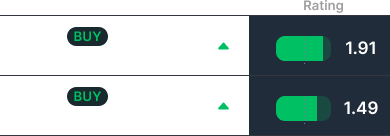Do you have an open position in a stock and want to hedge against any possible downside? Are you looking for a way to capitalize on your theory that a stock is going to drop in value? If so, you have come to the right place. Today, we’re going to teach you how to short a stock with options!
We’ll discuss the benefits of shorting a stock with options along with the downside you need to be aware of. We’ll also cover the strategies you can use when taking a short stance on a stock through options trading. With the help of VectorVest, you can effortlessly win more trades with less work – and we’ll discuss how the system fits into your trading strategy below. But first, let’s set the stage for the rest of our conversation today…
Featured Courses:
What Does it Mean to Short a Stock With Options?
First – what does it mean to short a stock with options? That’s a lot of investment jargon in one single phrase…but really, this is just a long-winded way of saying you’re making a calculated bet as to which direction a stock’s price is going to go.
Shorting a stock with options is a technique used by investors who believe a particular stock will decrease in value over time. When you short a stock, you borrow shares of the stock from your broker and immediately sell them on the market with the expectation of buying them back at a lower price in the future, pocketing the difference as profit.
However, when you short a stock with options, you don’t actually borrow the shares of the stock. Instead, you purchase an options contract that gives you the right, but not the obligation, to sell the underlying stock at a specified price (known as the “strike price”) at or before a specified date in the future (known as the “expiration date”).
If the stock’s price goes down before the expiration date, you can exercise your option and sell the stock at the higher strike price, pocketing the difference as profit. If the stock’s price doesn’t decrease, you can simply let the option expire and lose only the premium paid for the option.
Maybe you can already see why having this technique in your arsenal is valuable – but below, we’ll break down all the options why you may want to take the time to learn how to short a stock with options.
Why Should You Learn How to Short a Stock With Options?
There are quite a few different reasons why it’s worth your time to learn how to short a stock with options. You can use this strategy as a standalone technique to earn virtually unlimited profits. Or, you can incorporate short selling as a means of hedging risk to another position you have open. Below, we’ll highlight 5 reasons this is a good tool to have in your shed:
- Profit from a stock’s decline: Shorting a stock with options allows you to profit from a stock’s decline without having to own the underlying shares. This can be especially useful in a bear market or when you have a negative outlook on a particular stock or industry.
- Limited risk: Shorting a stock with options can be less risky than traditional short selling because your potential losses are limited to the premium paid for the option. This can be especially appealing if you are risk-averse or want to limit your exposure to the market.
- Hedging: Shorting a stock with options can also be used as a hedging strategy to protect against potential losses in a long position. For example, if you own a stock that you believe may decline in the short term, you could purchase a put option on that stock to hedge your position and potentially offset some of your losses.
- Speculation: Shorting a stock with options can also be used for speculative purposes, such as betting on a stock’s decline based on technical analysis or market trends. This can be a more aggressive strategy that requires careful consideration of risk and reward.
- Flexibility: Options contracts offer a high degree of flexibility, allowing you to choose the strike price, expiration date, and other terms of the contract to suit your investment goals and risk tolerance.
What’s the Risk of Shorting a Stock With Options?
Now – before we actually teach you how to short a stock with options, it’s important to be aware of the downside. While there are substantial benefits to be gained from short selling options contracts, investors do take on a fair amount of risk through this tactic as well.
First and foremost, how stock options work is vastly more complicated than traditional trading techniques – like swing trading or day trading. There are more moving parts to this strategy and it’s quite complex. That means beginners should take the time to learn options trading in-depth before attempting to short contract. Our guide to trading options for beginners is a great starting point.
With that said, even experienced investors need to be aware of the risk associated with taking a short position with options contracts.
Options contracts have a finite expiration date, which means you need to be right about the stock’s decline within a specific time frame. If the stock doesn’t decline before the stock options expiration date arrives, you could lose the premium paid for the option. Because of this, we mainly recommend this strategy when you have a short-term, bearish stance on a stock.
Moreover, options prices are influenced by implied volatility, which is a measure of the market’s expectations for the stock’s price movements. If implied volatility increases, the price of the options contract may also increase, which could reduce your potential profit or increase your potential loss.
But perhaps the biggest risk of taking a short position on any stock is the risk of amplified losses. While shorting a stock with options can limit your potential losses to the premium paid for the option, losses can still be amplified if the stock declines more than expected or if you use options contracts with a high degree of leverage.
The good news? Many of these risks can be avoided by taking the time to read our guide on risk management options trading. Or, simply keep reading below to learn how to short a stock with options. We’ll also discuss setting yourself up for success with a quality stock forecasting software. Let’s get into the details of actually shorting a stock with options…
How to Short a Stock With Options to Hedge Risk & Maximize Profits
Below, we’ll break down the six steps standing between you and successfully shorting a stock with options – ideally, earning a nice profit along the way. The obvious first step is finding the stock you want to short, so let’s start there.
Step 1: Choose a Stock to Short
The first step in shorting a stock with options is to identify a stock that you believe will decline in price. Maybe you have an open position in a company already and want to use shorting as a means of hedging that position – if so, no need to read this section.
But if you’re looking for a starting point, you can choose a stock based on your analysis of the stock’s fundamentals, technical analysis, or broader market trends. You can use moving averages or complex technical indicators. Or, you can save yourself a whole lot of time, stress, and human error by using the VectorVest stock analyzer software.
This system has helped countless investors increase their profits while minimizing losses. It also saves you a ton of time by telling you exactly what to buy, when to buy it, and when to sell it. It doesn’t get much easier than that! Whether you’re wondering how to pick a stock for options trading or you want to find the best swing trading stock picks – VectorVest can help you uncover the best opportunities at any given time.
For the sake of this conversation, let’s say you have used VectorVest to spot a trend early, and you believe that XYZ Company’s stock is overvalued and will decline in the coming weeks. Now what?
Step 2: Choose the Type of Options Contract to Use
Once you’ve identified a stock to short, you’ll need to choose the type of options contract to use. There are two main types of options contracts: calls and puts. Call options give you the right – but not the obligation – to buy a stock at a predetermined price, whereas a put option gives you the right – but not the obligation – to sell a stock at a predetermined price.
For the example above, you’d want to buy a put option which allows you to then sell the stock at a higher price on the market should your theory prove true and the underlying stock in question drops in value. Of course, if you have the opposite stance – and expect the stock in question to rise in value – you’d buy a call option, so you can then buy the stock at a discount and flip it at a premium.
Once you’ve determined the stance you’re going to take on the stock and the type of contract that best suits your needs, you’ll need to configure a strike price and expiration date that works in your favor.
Step 3: Determine the strike price and expiration date
The strike price is the price at which you have the right to sell the stock, and the expiration date is the date by which the option must be exercised or it will expire. Both of these are important components in successfully shorting a stock through options trading.
The strike price and expiration date will depend on your investment goals and risk tolerance. For example, you might choose a strike price that is slightly below the current market price of the stock and an expiration date that is several weeks or months in the future.
Sticking with our example above – where you expect a stock to fall in price – you want to make sure you have enough time to prevent time decay from working against you. You want an expiration date at least 6 months out.
In terms of the strike price, there is a direct correlation between how close your strike price is to the current stock price and how much premium you pay for the contract – so you’ll have to toe that line carefully to make sure you give yourself enough room for profit without taking on too much risk.
Step 4: Manage the Position & Exercise the Option When the Time Comes
Once you’ve purchased your put option, you’ll need to monitor the stock price and the value of the option. If the stock price declines and falls below the strike price of the option, the option will increase in value, which means you can exercise the option and sell those shares for a profit. This is how you capitalize on a stock’s decline as an investor.
However, the closer that expiration date gets while your contract is out of the money (the strike price is lower than the current stock price), the less value your contract has. You’ll want to watch the position carefully and determine if it makes sense to flip your options contract to try and recoup any premium you paid.
Other Ways to Short a Stock With Options Besides Basic Puts
Simply buying a put contract for a stock that you believe will decline in value is perhaps the easiest way to short a stock. But, there are other – albeit more complex – techniques in which you can take a short position on a stock with options.
For example, let’s say you take the opposite stance in our example above – you expect the stock is going to rise in value as it’s greatly underbought and undervalued. Instead of buying put options, you could write call options yourself.
Here, you’d make a profit by selling these contracts to other investors, who pay you a premium for the stock. And unlike put options, time decay is your friend here. The closer the expiration date gets while the underlying stock price remains above the strike price you’ve written, the less likely you’ll have to pay out the difference.
This technique is dramatically riskier as your upside is limited to the premium you earn, and your downside is virtually unlimited. Our advice if you’re going to use this technique is to write strike prices that are near the stock’s strongest point of resistance, as this minimizes your exposure.
Here are a few other ways to short a stock with options:
- Covered Puts
- Bear Put Vertical Spreads
- Bear Call Vertical Spreads
- Synthetic Shorts With Options
Each of these is an entirely separate technique and is a bit more complicated than necessary for the sake of this article.
Ultimately, the best way to short a stock with options is by simply purchasing put options of stocks you expect to decline in value. If you suspect a stock is going to rise in value, you should simply buy the stock outright or purchase a call option. As you become a more seasoned trader, you can start to look into some of these more complex strategies listed above.
Final Thoughts on How to Short a Stock With Options
It’s time to bring our conversation on how to short a stock with options to a close. As you can see, you can always make money in the stock market – whether the stocks in question are rising or falling in value. By leveraging the power of options contracts, you can hedge open positions you have to offset risk or simply take a short stance to earn profits while a stock falls.
If you want to learn more about how shorting a stock works or short selling ETFs, explore our blog. We have other resources related to options as well – including articles on stock warrants vs options, what happens when you exercise a put option, swing trading options, how to buy and sell options, and a whole lot more.
Otherwise, it’s time to get set up with VectorVest and see firsthand what this software can help you accomplish – whether you’re shorting a stock with options, swing trading, day trading, or investing long-term!
Featured Courses:
What you should do next…
- Get our latest blogs delivered right to your inbox, subscribe to our newsletter.
- The market moves fast! Get our most current evaluation of this stock with our FREE stock analysis tool.
- Looking for stock picks? Not sure if now is the right time to buy/sell? For a limited time, enjoy the full benefits of a 30-day subscription to VectorVest for only [offer_txt] (usually up to [saving_txt]/month) . Get access to our full list of screeners showcasing our top stock picks that tell you exactly what to buy, when to buy, and when to sell.











